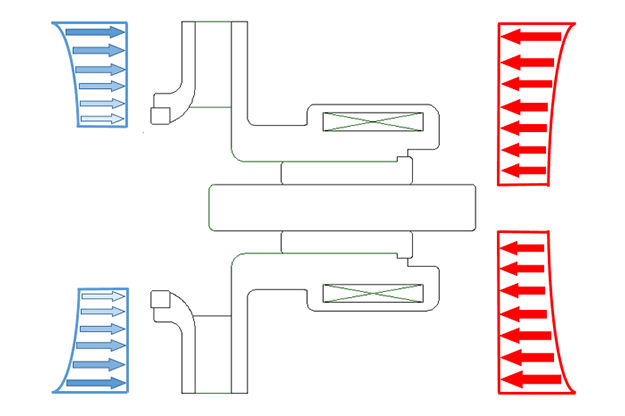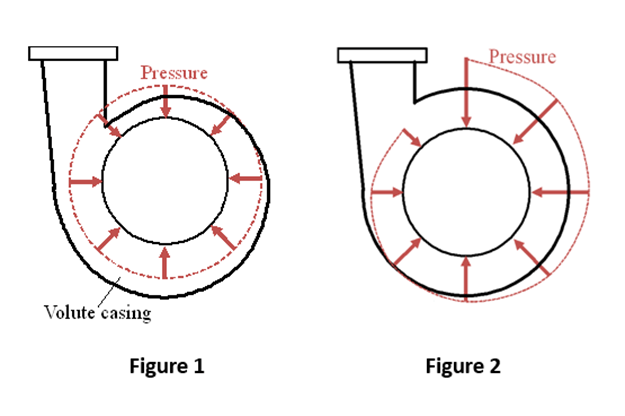Axial Force&Radial Force
Axial force, 
Axial force is the pressure exerted by the pumped liquid on the impeller in the axial direction during
operation. The impeller on the seal-less pump is not fixed in the axial direction. Therefore, front and rear
thrust rings are necessary to prevent axial force on the impeller from generating excessive friction. If , the axial force is towards the rear of
the pump, causing the impeller to be in contact with the rear thrust ring. If
, the axial force is towards the rear of
the pump, causing the impeller to be in contact with the rear thrust ring. If , the axial force is directed towards the
front of the pump, causing the impeller to press against the front thrust ring. Under normal operation, the
suction of the impeller is a low pressure zone, therefore, the axial force should push the impeller forward.
, the axial force is directed towards the
front of the pump, causing the impeller to press against the front thrust ring. Under normal operation, the
suction of the impeller is a low pressure zone, therefore, the axial force should push the impeller forward.
Axial force is one of the factors determining the service life of the wear parts, therefore, some measures are usually employed to reduce axial force, including adding balance holes, adding back vanes, etc.

 , the axial force is towards the rear of
the pump, causing the impeller to be in contact with the rear thrust ring. If
, the axial force is towards the rear of
the pump, causing the impeller to be in contact with the rear thrust ring. If , the axial force is directed towards the
front of the pump, causing the impeller to press against the front thrust ring. Under normal operation, the
suction of the impeller is a low pressure zone, therefore, the axial force should push the impeller forward.
, the axial force is directed towards the
front of the pump, causing the impeller to press against the front thrust ring. Under normal operation, the
suction of the impeller is a low pressure zone, therefore, the axial force should push the impeller forward.Axial force is one of the factors determining the service life of the wear parts, therefore, some measures are usually employed to reduce axial force, including adding balance holes, adding back vanes, etc.

Radial Force, 
Radial force is the pressure exerted by the pumped liquid on the impeller in the radial direction during
operation. Theoretically, when the pump is operating under its rated flow rate, the pressure exerted along the
volute casing is evenly distributed, exerting zero radial force on the impeller (Figure 1). If the casing design
is a concentric circle relative to the impeller, then the pressure will be highest at the tongue of the casing
and decreases along the casing towards the throat of the casing, exerting a net positive radial force on the
impeller (Figure 2). If the radial force is not balanced, it will be exerted as an additional loading on the
shaft and bearing.



